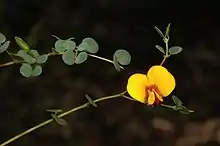| Bossiaea lenticularis | |
|---|---|
 | |
| In the Australian National Botanic Gardens | |
| Scientific classification | |
| Kingdom: | Plantae |
| Clade: | Tracheophytes |
| Clade: | Angiosperms |
| Clade: | Eudicots |
| Clade: | Rosids |
| Order: | Fabales |
| Family: | Fabaceae |
| Subfamily: | Faboideae |
| Genus: | Bossiaea |
| Species: | B. lenticularis |
| Binomial name | |
| Bossiaea lenticularis | |
Bossiaea lenticularis is a species of flowering plant in the family Fabaceae and is endemic to eastern New South Wales. It is a slender, spreading shrub with mostly circular leaves, and yellow and red flowers.
Description
Bossiaea lenticularis is a slender spreading shrub that typically grows to a height of up to 1 m (3 ft 3 in) and is more or less glabrous. The leaves are mostly circular, 2–8 mm (0.079–0.315 in) long in diameter with stipules up to 1 mm (0.039 in) long at the base. The flowers are 6–12 mm (0.24–0.47 in) long, each flower on a pedicel up to about 5 mm (0.20 in) long with a few bracts up to 1.0 mm (0.039 in) long. The sepals are 4–6 mm (0.16–0.24 in) long joined at the base with bracteoles on the pedicel. The standard petal is yellow with red markings, the wings yellow and the keel dark reddish with a paler base. Flowering occurs from August to September and the fruit is an oblong to egg-shaped pod 10–30 mm (0.39–1.18 in) long.[2][3]
Taxonomy and naming
Bossiaea lenticularis was first formally described in 1825 by Augustin Pyramus de Candolle in Prodromus Systematis Naturalis Regni Vegetabilis from an unpublished description by Franz Sieber.[4][5] The specific epithet (lenticularis) means "lens-shaped".[6]
Distribution and habitat
This bossiaea grows in forest, mainly in the Sydney region and as far inland as Lithgow.[2]
References
- ↑ "Bossiaea lenticularis". Australian Plant Census. Retrieved 4 August 2021.
- 1 2 "Bossiaea lenticularis". Royal Botanic Garden Sydney. Retrieved 4 August 2021.
- ↑ Wood, Betty. "Bossiaea lenticularis". Lucid Keys. Retrieved 4 August 2021.
- ↑ "Bossiaea lenticularis". APNI. Retrieved 4 July 2021.
- ↑ de Candolle, Augustin P. (1825). Prodromus Systematis Naturalis Regni Vegetabilis. Vol. 2. Paris. p. 117. Retrieved 4 August 2021.
- ↑ Sharr, Francis Aubi; George, Alex (2019). Western Australian Plant Names and Their Meanings (3rd ed.). Kardinya, WA: Four Gables Press. p. 238. ISBN 9780958034180.